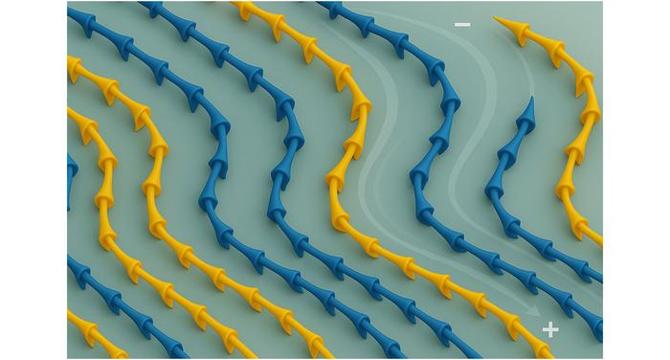Bioengineer
2w
112

Image Credit: Bioengineer
Controlling Magnetic Textures Using Electric Fields
- Researchers at the Paul Scherrer Institute have developed a groundbreaking method to control magnetism using electric fields in magnetoelectric materials, opening avenues for energy-efficient electronics.
- The research focuses on copper oxyselenide, a unique material where atomic spins form complex nanoscale magnetic patterns like helices and cones that can be manipulated electrically.
- By applying finely tuned electric fields, the team successfully steered magnetic textures without the need for traditional magnetic fields, enabling magnetoelectric deflection.
- Utilizing neutron scattering at the Swiss Spallation Neutron Source, the researchers observed real-time responses of the magnetic textures to electric field variations.
- The study identified three distinct response regimes to electric fields, showcasing smooth deflection, complex nonlinear behavior, and abrupt 90-degree flips in magnetic texture orientation.
- This breakthrough offers potential for developing ultra-fast, energy-efficient memory and sensor devices by leveraging controllable magnetic trajectory flips in future device architectures.
- The research signifies a shift towards energy-efficient magnetism manipulation, positioning electric field control as a sustainable alternative for information storage and magnetic logic operations.
- The ability to tune magnetic textures in copper oxyselenide presents new opportunities for exploring spin-orbit coupling and magnetoelectric interactions, driving interdisciplinary research in materials science.
- Ultimately, the study highlights the potential of magnetoelectric materials in creating low-power, high-speed nanomagnetic devices and sustainable computing infrastructure through precise electric field manipulation.
- The findings extend beyond computing to applications in energy conversion and medical devices, emphasizing the broad impact of magnetoelectric control for enhancing sensor and actuator technologies.
- This research underscores the transformative potential of magnetoelectric materials in advancing electronics and technology applications, showcasing the power of interdisciplinary research and advanced experimentation techniques.
Read Full Article
6 Likes
For uninterrupted reading, download the app